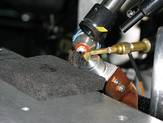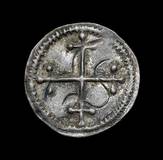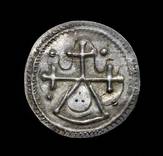- Steering group and management
- Sub-projects
- Jelling in GIS (Geographic Information System)
- Geophysical survey at Jelling
- Fieldwork 2011
- Archaeological fieldwork 2010
- Archaeological fieldwork 2009
- Jelling’s large stones
- The landscape around Jelling
- Place names in Jelling and its vicinity
- The bridge over Ravning Enge
- The travertine churches of East Jutland.
- Rune stones in context 2011
- Power and coins 2009
- Exhibitions
- Digitizing the photographs
Power and coins 2009
Around 975 Harald Bluetooth introduced a new coinage to Denmark. This took place around 10 years after the king erected the large rune stone at Jelling as a symbol of the gathering of the kingdom and the new Christian faith. The new thin coins bear cross motifs and may be an expression of the wish to spread the new religious faith. Study of the treasure hoards of the period shows that Danish coins suddenly began to play a much bigger part in those which were circulating and much points toward Harald aiming to introduce a national coinage. A national coinage, which was exclusively based upon Danish coins, would confirm the king’s power and at the same time secure an economic foundation.
Harald Bluetooth’s coins
For most of the 900s the weight economy dominated in Denmark. Jewellery, ingots, and Danish and foreign coins of precious metal, were cut into pieces and used as payment by weight. The shape of the metal was of secondary importance, it was its quality that was decisive. From around the year 975 a change occurred in the composition of treasure hoards. Danish coins now dominated and were not cut into pieces like the earlier Islamic coins. This indicates that the coins were used according to their face value and total, and not any longer based on their weight. Such a change could happen through the king introducing a coin monopoly, which secured a standardised, commonly recognized and accepted currency. Foreign coins had to be banned and Harald Bluetooth could secure his power and income by circulating his own more valuable coins.
Harald Bluetooth’s attempt to establish a national coinage did not last. Many foreign coins continued to circulate in Denmark and a genuine national coinage first became properly established during the reign of Sweyn II Estridsen in the years 1047-1074.
Harald Bluetooth’s silver
The treasure hoards of the 900s show considerable importation of silver “dirhams” from Muslim areas of Central Asia. At the end of the century the level of this importation fell in the whole of the Baltic area. Harald Bluetooth’s new silver coins may be melted down Islamic coins. A precise identification of the silver’s place of origin demands an analysis of the metal. Every silver mine has its own “finger print” of trace elements (impurities) and trace elements in the silver can be identified by non-destructive metallurgical tests.
If the metal is proved to consist of melted down dirhams, it indicates a completely conscious political choice on the part of Harald Bluetooth to mint his own Christian coins. If, on the other hand, the silver originates from silver mines in Harzen, Germany, this could represent an attempt to find new sources of silver supply. A need for silver from Harzen may have influenced Harald Bluetooth’s relationship with the Ottonian rulers in Germany.
Objective
The project aims to analyse Harald Bluetooth’s coins in order to establish the silver’s place of origin. This will help shed light upon the king’s trading options and possible dependence upon the German emperors. Demonstration of a possible attempt to introduce a genuine national coinage will also lead to an investigation of Harald Bluetooth’s role as ruler in Denmark.
The project also has the aim of a thorough investigation involving bending, fragmenting and testing of coins from Harald’s time. The objective of this investigation is to shed light upon the change in the way coins were used during the transition from a weight to a coin economy.
The metal composition of 65 coins was investigated in April 2009 at the C2RMF Laboratory in Paris in order to establish the silver’s place of origin. This took place in connection with the EU-financed Eu-ARTECH programme.
Project coordinator: Museum Inspector Jens Christian Moesgaard, the Royal Collection of Coins and Medals, the National Museum.




